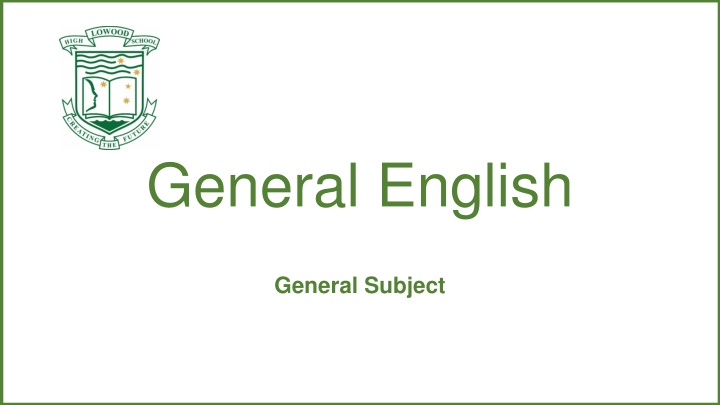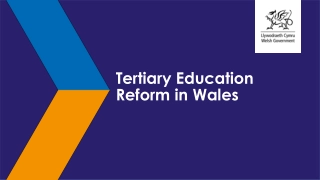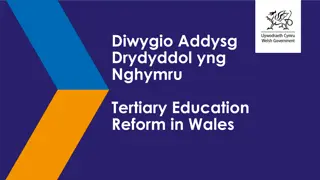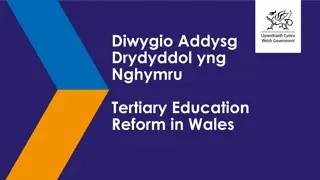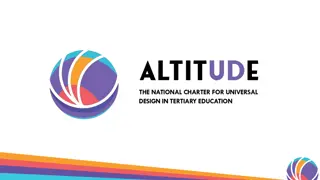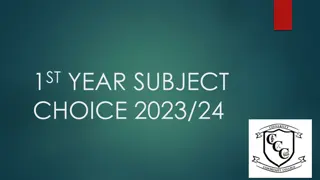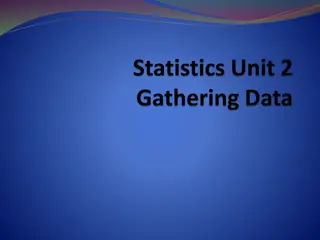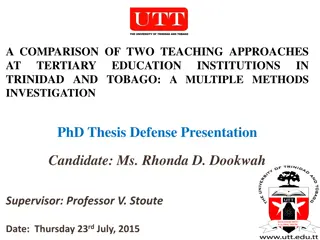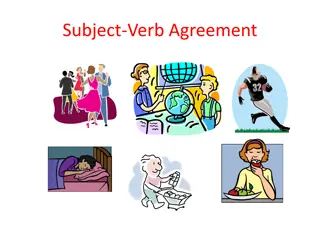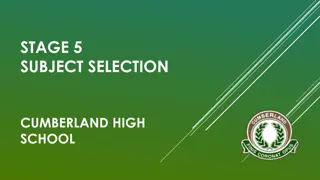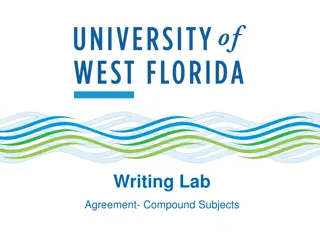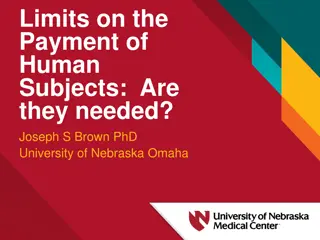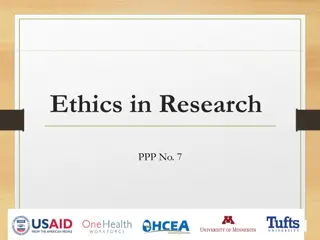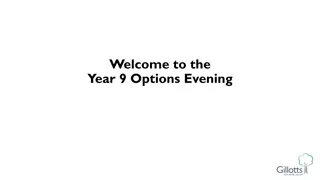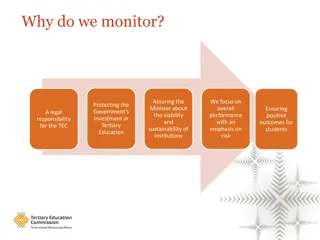Introduction to General English Subjects for Tertiary Studies
General subjects in English are designed for students interested in pathways beyond secondary schooling. These subjects contribute to QCE and ATAR awards, requiring high-level skills in literacy, numeracy, and 21st-century skills. Prerequisites include maintaining a B grade in Year 10. Units cover topics like perspectives, texts, cultures, madness, and creative responses, focusing on textual analysis, literary exploration, and cultural perspectives. Success in General English is crucial for achieving academic goals.
Download Presentation

Please find below an Image/Link to download the presentation.
The content on the website is provided AS IS for your information and personal use only. It may not be sold, licensed, or shared on other websites without obtaining consent from the author.If you encounter any issues during the download, it is possible that the publisher has removed the file from their server.
You are allowed to download the files provided on this website for personal or commercial use, subject to the condition that they are used lawfully. All files are the property of their respective owners.
The content on the website is provided AS IS for your information and personal use only. It may not be sold, licensed, or shared on other websites without obtaining consent from the author.
E N D
Presentation Transcript
General English General Subject
General Subjects General Subjects General Subjects are suited to students who are interested in pathways beyond senior secondary schooling that lead to tertiary studies. Results in General subjects contribute to the awarded of a QCE and can contribute to an ATAR. Students will need high level underpinning skills in literacy, numeracy and 21stcentury skills to be successful in these subjects. Students must have undertaken Investigating Global Connections and English in year 10, maintaining a grade of a B to enter this subject.
Frequently Asked Questions Frequently Asked Questions Why are there pre-requisites to enter this subject? It is important that you are working at a B achievement standard in Year 10 to go into an ATAR Pathway for English. This means that the skill set you have developed and demonstrated is working toward the standard in Year 11 and 12 General English. It is common that someone entering General English will drop a grade point. We want to make sure you are set up for success and have the relevant skills and knowledge to be successful in General English in Year 11 and 12, ensuring you get your QCE and desired ATAR.
Frequently Asked Questions Frequently Asked Questions What are the Units and Topics studied in this subject? Unit 1 (Year 11) Be Warned I grew up in (Human Experience) TOPIC: Perspectives and texts TOPIC: Texts and cultures Unit 2 (Year 11) Unit 3 (Year 12) Representations of Madness TOPIC 1: Conversations about concept in texts Unit 4 (Year 12) Welcome to the End TOPIC 1: Creative responses to texts In Unit 1, students explore individual and/or collective experiences and perspectives of the world through engaging with a variety of texts in a range of contexts. They examine how perspectives and representations of concepts, identities and/or groups are constructed through textual choices such as language, medium, style and text structures. This unit allows students to explore how meaning is shaped through the relationships between language, text, purpose, context and audience. Students respond to a variety of non-literary texts and literary texts, and create texts of their own for a variety of purposes and audiences. In responding to texts, students analyse the perspectives and representations of concepts, identities and/or groups in texts and how these shape their own and others ideas and perspectives. Analysis may include, for example: - examining ways in which concepts, identities and/or groups are reported differently in the media and how these are represented to position readers and viewers - exploring how writers convey perspectives and representations through textual structures, conventions, style and language, and how the meaning of a text is affected by the contexts in which it is created and received - examining ways perspectives and representations are conveyed through argument, rhetoric, tone, register, style and language to influence audiences. In creating texts, students demonstrate their understanding of the relationships between text, purpose, context and audience by purposefully shaping perspectives and representations of concepts, identities/and or groups. Students experiment with, and make choices about, textual structures, medium, conventions and language to develop voice and style and position audiences. In Unit 2, students explore cultural experiences of the world through engaging with a variety of texts, including a focus on Australian cultures for at least half of the unit. Building on Unit 1, students develop their understanding of how relationships between language, text, purpose, context and audience shape meaning and cultural perspectives. By engaging with a variety of texts, including Australian texts, students examine the relationship between language and identity, the effect of textual choices and the ways in which these choices position audiences for particular purposes, revealing attitudes, values and beliefs. Students respond to and create imaginative and analytical texts of their own. This topic includes the examination of two different types of text, e.g. a novel and film, a novel and a play, a documentary and a play, an op-ed article and a novel, a speech and a novel, a selection of poetry and film, a film and a play, a selection of poetry and a novel. By engaging with literary texts, students experiment with innovative and imaginative use of language, style and textual elements in order to create their own imaginative texts that promote emotional and critical reactions in readers. In creative responses, students challenge ideas and conventions and reimagine perspectives by applying their own knowledge of literary text structures and styles to shape their own representations. Literary texts appropriate to the focus of this topic include: short stories, poetry, a novel or non-fiction text, a play, multimodal texts, such as film or television programs. Study in this unit will include two texts that are either: - connected by the representation of concepts, identities, times and places or - transformations or adaptations of (or interventions into) other texts, such as reimagined literary texts or film versions of texts or plays. In responding to two texts, students explore and discuss the personal, social, historical and cultural significance of representations in different texts and the cultural assumptions, attitudes, values and beliefs underpinning them. Students are given opportunities to add to ongoing, informed and public conversations about both literary texts and non-literary texts. In responding to texts, students analyse the relationship between language, representation, identity and cultural context, uncovering cultural assumptions, attitudes, values and beliefs that underpin texts. In creating texts, students purposefully shape perspectives and representations that reveal certain cultural attitudes, values and beliefs. TOPIC 2: Conversations about issues in texts TOPIC 2: Critical responses to texts Students will analyse different perspectives by examining representations of the same issue in different texts. Students will explore how texts position readers and viewers, and develop their capacity to analyse and contest complex and challenging ideas and the assumptions, attitudes, values and beliefs underpinning them. They will focus on how the power of language and argument are used to construct particular perspectives of similar issues in different texts to prepare for the construction of their own persuasive argument in relation to an issue. Students will produce a variety of persuasive texts of their own and the unit will culminate in a spoken persuasive text. Through a close, critical study of a literary text and various interpretations of it, students strengthen their capacity to develop their own analytical response to it. Students independently develop and compose original, analytical texts.
Frequently Asked Questions Frequently Asked Questions What texts do we study in this subject? Some of the texts you may study are listed below. Year 11: The Crucible by Arthur Miller Nineteen Eighty-Four by George Orwell Selection of Australian Poetry Year 12: Collection of Sylvia Plath Poetry Little Miss Sunshine (film) Blade Runner (film) Nineteen Eighty-Four by George Orwell Macbeth by William Shakespeare Othello by William Shakespeare
Frequently Asked Questions Frequently Asked Questions What assessments do I have to complete in this subject? (Year 11) Unit 1 (Year 11) Be Warned ASSESSMENT 1: Extended written for public audience Unit 2 (Year 11) I grew up in (Human Experience) ASSESSMENT 3: Examination imaginative written This assessment focuses on the analysis, interpretation and examination of concepts in texts. It is an open- ended task responding to texts connected by the representation of a concept, identity, time or place, and written for a public audience. Students may support their responses with digital elements appropriate to the type of publication. This internal assessment focuses on the interpretation of a literary text from the prescribed text list as a springboard for an imaginative response. It is a supervised task that assesses a range of cognitions when responding to a particular situation, task or scenario. Student responses must be completed individually, under supervised conditions, and in a set timeframe and students should have one week s notice of the task. Conditions Written: 1000 1500 words (may be accompanied by digital elements appropriate to the type of publication) Duration: 5 weeks notification and preparation Open access to resources Conditions Written: 800 1000 words Time: 2 hours plus planning (15 minutes) Other: o students to be given the specific task one week prior to the assessment o no access to teacher advice, guidance or feedback once the task is distributed o clean copy of the text used as a springboard allowed o no notes allowed ASSESSMENT 4: ASSESSMENT 2: Extended persuasive spoken This assessment focuses on the creation of a perspective through reasoned argument to persuade an audience. It is an open-ended task responding to representations of a contemporary social issue in the media within the previous year. While students may undertake some research in the production of the extended response, it is not the focus of this technique. Students may support their responses with multimodal elements, such as digital, appropriate to the context and audience. The examination is an analytical response to a literary text in the form of an analytical essay for an audience with a deep understanding of the text. The purpose is to communicate an informed and critical perspective of the text in response to an unseen question or task studied in-depth in Unit 2. Conditions Time: 2 hours plus planning time (15 minutes) Length: 800 1000 words. Conditions Spoken: 5 8 minutes; while this task is spoken, a student may use multimodal/digital components to support the development of the response; the response may be live or pre-recorded. Duration: 4 weeks notification and preparation Individual response.
Frequently Asked Questions Frequently Asked Questions What assessments do I have to complete in this subject? (Year 12) Unit 3 (Year 12) Representations of Madness ASSESSMENT 1: Extended written for public audience Unit 4 (Year 12) Welcome to the End ASSESSMENT 3: Examination imaginative written This assessment focuses on the analysis, interpretation and examination of concepts in texts. It is an open- ended task responding to two texts connected by the representation of a concept, identity, time or place, and written for a public audience. One of the studied texts must be a literary text from the prescribed text list. Students may support their responses with digital elements appropriate to the type of publication. This internal assessment focuses on the interpretation of a literary text from the prescribed text list as a springboard for an imaginative response. It is a supervised task that assesses a range of cognitions when responding to a particular situation, task or scenario. Student responses must be completed individually, under supervised conditions, and in a set timeframe and students should have one week s notice of the task. Conditions Written: 1000 1500 words (may be accompanied by digital elements appropriate to the type of publication) Duration: 5 weeks notification and preparation Open access to resources Conditions Written: 800 1000 words Time: 2 hours plus planning (15 minutes) Other: o students to be given the specific task one week prior to the assessment o no access to teacher advice, guidance or feedback once the task is distributed o clean copy of the text used as a springboard allowed o no notes allowed ASSESSMENT 4: ASSESSMENT 2: Extended persuasive spoken This assessment focuses on the creation of a perspective through reasoned argument to persuade an audience. It is an open-ended task responding to representations of a contemporary social issue in the media within the previous year. While students may undertake some research in the production of the extended response, it is not the focus of this technique. Students may support their responses with multimodal elements, such as digital, appropriate to the context and audience. Summative external assessment is developed and marked by the QCAA. In English it contributes 25% to a student s overall subject result. The external assessment in English is common to all schools and administered under the same conditions, at the same time, on the same day. The examination is an analytical response to a literary text from the prescribed text list in the form of an analytical essay for an audience with a deep understanding of the text. The purpose is to communicate an informed and critical perspective of the text in response to an unseen question or task studied in-depth in Unit 4. Conditions Spoken: 5 8 minutes; while this task is spoken, a student may use multimodal/digital components to support the development of the response; the response may be live or pre-recorded. Duration: 4 weeks notification and preparation Individual response. Conditions Time: 2 hours plus planning time (15 minutes) Length: 800 1000 words.
Frequently Asked Questions Frequently Asked Questions Does this subject have an external exam and what is it worth? Yes, General English does have an External Exam. It is based on the novel studied in Unit 4 Topic 2. We are currently studying Nineteen Eighty-Four by George Orwell for this exam. In 2023, this novel may be different as the QCAA update the prescribed Text List. The external exam in English is worth 25%.
Year 11 Text Samples Year 11 Text Samples
Year 12 Text Samples Year 12 Text Samples
Contact Details Contact Details If you require any further details about this course please feel free to contact: Subject area Teacher: Aly Brown abrow805@eq.edu.au Melissa Shipton mship23@eq.edu.au Emma Hayes ehaye40@eq.edu.au Head of Department: Emma Hayes ehaye40@eq.edu.au
